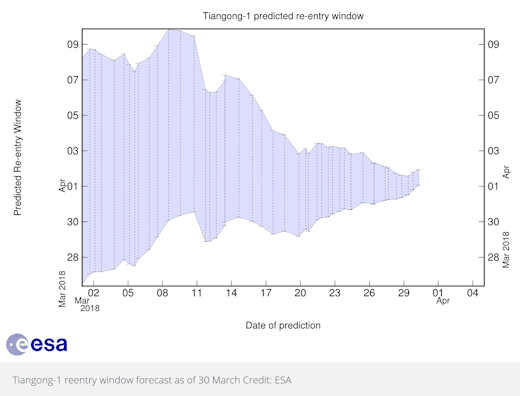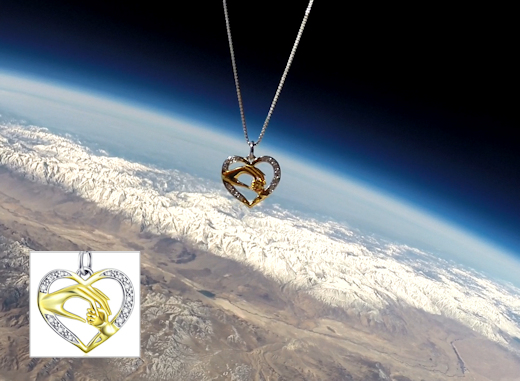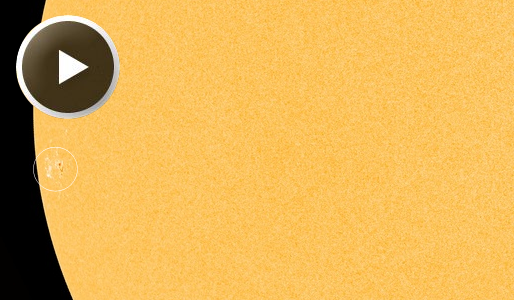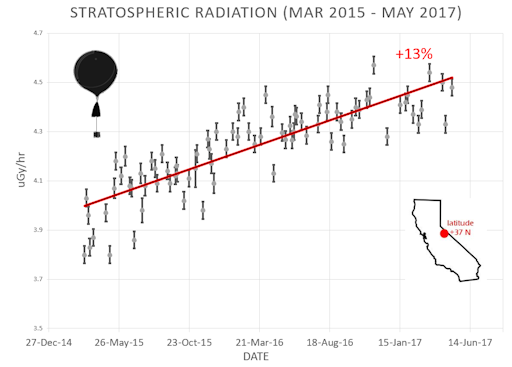 | | | Switch to: Europe, USA, New Zealand, Antarctica Credit: NOAA/Ovation  Planetary K-index Planetary K-index
Now: Kp= 1 quiet
24-hr max: Kp= 2 quiet
explanation | more data
Interplanetary Mag. Field
Btotal: 5.8 nT
Bz: 1.4 nT north
more data: ACE, DSCOVR
Updated: Today at 2355 UT  Coronal Holes: 30 Mar 18 Coronal Holes: 30 Mar 18 
Solar wind flowing from the indicated coronal hole is brushing against Earth's magnetic field today. Credit: SDO/AIA  Noctilucent Clouds Our connection with NASA's AIM spacecraft has been restored! New images from AIM show that the southern season for noctilucent clouds (NLCs) is underway. Come back to this spot every day to see AIM's "daily daisy," which reveals the dance of electric-blue NLCs around the Antarctic Circle.. Switch view: Ross Ice Shelf, Antarctic Peninsula, East Antarctica, Polar Updated at: 02-07-2018 17:55:05 Noctilucent Clouds Our connection with NASA's AIM spacecraft has been restored! New images from AIM show that the southern season for noctilucent clouds (NLCs) is underway. Come back to this spot every day to see AIM's "daily daisy," which reveals the dance of electric-blue NLCs around the Antarctic Circle.. Switch view: Ross Ice Shelf, Antarctic Peninsula, East Antarctica, Polar Updated at: 02-07-2018 17:55:05  SPACE WEATHER
NOAA Forecasts | | Updated at: 2018 Mar 30 2200 UTC FLARE | 0-24 hr | 24-48 hr | CLASS M | 01 % | 01 % | CLASS X | 01 % | 01 % |  Geomagnetic Storms: Geomagnetic Storms:
Probabilities for significant disturbances in Earth's magnetic field are given for three activity levels: active, minor storm, severe storm Updated at: 2018 Mar 30 2200 UTC Mid-latitudes | 0-24 hr | 24-48 hr | ACTIVE | 15 % | 10 % | MINOR | 05 % | 01 % | SEVERE | 01 % | 01 % | High latitudes | 0-24 hr | 24-48 hr | ACTIVE | 20 % | 15 % | MINOR | 25 % | 20 % | SEVERE | 20 % | 15 % | | | |  | | | | | | | | | | | All-inclusive Northern Lights trips in Tromsø, Norway. Small groups, big experiences! Highly qualified guides ensure unique and unforgettable adventures with a personal touch. Visit Explore the Arctic | | | SPACE WEATHER DELAYS THE RETURN OF TIANGONG-1: China's Tiangong-1 space station will remain in orbit a few hours longer than expected, according to the European Space Agency. Re-entry is now predicted to occur sometime between the night of March 31st and the late evening of April 1st (in UTC time). "Today's forecast is a noticeable change from that of yesterday, and is due to solar activity," says the ESA Space Debris Office. "A high-speed stream of particles from the sun, which was expected to reach Earth and influence our planet's geomagnetic field on March 30th, did not, in fact, have any effect. This means that the density of the upper atmosphere, through which Tiangong-1 is moving, did not increase as predicted (which would have dragged the spacecraft down sooner)." 
The precision of today's forecast, while improving, is still not sufficient to pinpoint the location of the fireball. Tiangong-1 may re-enter almost anywhere on Earth between latitudes 43ºN and 43ºS: map. Stay tuned for updates as the doomed spacecraft sinks deeper into the atmosphere. MOTHER'S DAY IS ONLY 6 WEEKS AWAY:On March 5, 2018, the students of Earth to Sky Calculus flew a cosmic ray balloon to the stratosphere, more than 94,000 feet above Earth's surface. This sterling silver Mother's Day pendant went along for the ride: 
You can have it for $119.95. The students are selling these pendants as a fund-raiser for their cosmic ray monitoring program. All proceeds support atmospheric radiation measurements and hands-on STEM education. Each pendant comes with a greeting card showing the jewelry in flight and telling the story of its journey to the stratosphere and back again. Mom-satisfaction guaranteed. Far Out Gifts: Earth to Sky Store
All proceeds support hands-on STEM education RARE SOLAR MINIMUM SUNSPOT: Almost every day this month, the face of the sun has been utterly blank. Today, however, a new sunspot is growing near the sun's southeastern limb, pocking the surface of our star with several Moon-sized dark cores. This movie from NASA's Solar Dynamics Observatory shows sunspot genesis in action: 
Only on the eve of Solar Minimum would such a puny sunspot attact attention--and that is exactly where we are. Sunspot numbers are plummeting toward a deep nadir of the solar cycle expected to hit bottom in 2019-2020. For the foreseeable future, every sunspot is a rarity worthy of note. This sunspot will probably remain small and quiet. But we could be wrong. Occasionally, potent sunspots emerge during Solar Minimum, unleashing powerful flares. Astronomers with backyard solar telescopes are encouraged to monitor this one ... just in case. Realtime Space Weather Photo Gallery
Realtime Aurora Photo Gallery
Every night, a network of NASA all-sky cameras scans the skies above the United States for meteoritic fireballs. Automated software maintained by NASA's Meteoroid Environment Office calculates their orbits, velocity, penetration depth in Earth's atmosphere and many other characteristics. Daily results are presented here on Spaceweather.com. On Mar. 30, 2018, the network reported 8 fireballs.
(8 sporadics)  In this diagram of the inner solar system, all of the fireball orbits intersect at a single point--Earth. The orbits are color-coded by velocity, from slow (red) to fast (blue). [Larger image] [movies] Potentially Hazardous Asteroids ( PHAs) are space rocks larger than approximately 100m that can come closer to Earth than 0.05 AU. None of the known PHAs is on a collision course with our planet, although astronomers are finding new ones all the time. On March 30, 2018 there were 1882 potentially hazardous asteroids.
 | Recent & Upcoming Earth-asteroid encounters: | Asteroid | Date(UT) | Miss Distance | Velocity (km/s) | Diameter (m) | | 2018 FB3 | 2018-Mar-25 | 9.3 LD | 15.9 | 33 | | 2018 FQ1 | 2018-Mar-25 | 5.7 LD | 5.9 | 15 | | 2018 FR1 | 2018-Mar-26 | 6.2 LD | 12.2 | 17 | | 2018 DH1 | 2018-Mar-27 | 9.2 LD | 14.4 | 224 | | 2016 SR2 | 2018-Mar-28 | 18.7 LD | 7.3 | 20 | | 2018 FU1 | 2018-Mar-28 | 12.3 LD | 5.9 | 15 | | 2018 FO4 | 2018-Mar-28 | 7.7 LD | 6.3 | 11 | | 2018 FU3 | 2018-Mar-29 | 17.7 LD | 8.4 | 20 | | 2018 FE4 | 2018-Mar-29 | 13.3 LD | 20.7 | 39 | | 2018 FB | 2018-Mar-29 | 4.9 LD | 8.5 | 55 | | 2018 FB2 | 2018-Mar-30 | 10 LD | 6.7 | 26 | | 2018 FK5 | 2018-Mar-30 | 0.4 LD | 11.5 | 8 | | 2010 GD35 | 2018-Mar-31 | 15.5 LD | 11.6 | 45 | | 2018 EM4 | 2018-Apr-01 | 6.3 LD | 6.2 | 31 | | 2004 FG29 | 2018-Apr-02 | 4 LD | 14.9 | 22 | | 2018 ER1 | 2018-Apr-02 | 15.6 LD | 4 | 26 | | 2018 EB | 2018-Apr-04 | 10.4 LD | 15.1 | 165 | | 2018 FW4 | 2018-Apr-05 | 9.8 LD | 11.6 | 35 | | 363599 | 2018-Apr-12 | 19.3 LD | 24.5 | 224 | | 2014 UR | 2018-Apr-14 | 9.3 LD | 4.4 | 17 | | 2016 JP | 2018-Apr-20 | 12 LD | 12.7 | 214 | | 2012 XL16 | 2018-Apr-23 | 15.8 LD | 6.1 | 28 | | 2013 US3 | 2018-Apr-29 | 10.1 LD | 7.7 | 214 | | 2018 FV4 | 2018-Apr-29 | 17.7 LD | 6.5 | 61 | | 2002 JR100 | 2018-Apr-29 | 10.8 LD | 7.7 | 49 | | 1999 FN19 | 2018-May-07 | 9.7 LD | 5.7 | 118 | | 2016 JQ5 | 2018-May-08 | 6.3 LD | 10.4 | 9 | | 388945 | 2018-May-09 | 6.5 LD | 9 | 295 | | 1999 LK1 | 2018-May-15 | 13.3 LD | 10 | 141 | Notes: LD means "Lunar Distance." 1 LD = 384,401 km, the distance between Earth and the Moon. 1 LD also equals 0.00256 AU. MAG is the visual magnitude of the asteroid on the date of closest approach. | | Cosmic Rays in the Atmosphere |
Readers, thank you for your patience while we continue to develop this new section of Spaceweather.com. We've been working to streamline our data reduction, allowing us to post results from balloon flights much more rapidly, and we have developed a new data product, shown here: 
This plot displays radiation measurements not only in the stratosphere, but also at aviation altitudes. Dose rates are expessed as multiples of sea level. For instance, we see that boarding a plane that flies at 25,000 feet exposes passengers to dose rates ~10x higher than sea level. At 40,000 feet, the multiplier is closer to 50x. These measurements are made by our usual cosmic ray payload as it passes through aviation altitudes en route to the stratosphere over California. What is this all about? Approximately once a week, Spaceweather.com and the students of Earth to Sky Calculus fly space weather balloons to the stratosphere over California. These balloons are equipped with radiation sensors that detect cosmic rays, a surprisingly "down to Earth" form of space weather. Cosmic rays can seed clouds, trigger lightning, and penetrate commercial airplanes. Furthermore, there are studies ( #1, #2, #3, #4) linking cosmic rays with cardiac arrhythmias and sudden cardiac death in the general population. Our latest measurements show that cosmic rays are intensifying, with an increase of more than 13% since 2015: 
Why are cosmic rays intensifying? The main reason is the sun. Solar storm clouds such as coronal mass ejections (CMEs) sweep aside cosmic rays when they pass by Earth. During Solar Maximum, CMEs are abundant and cosmic rays are held at bay. Now, however, the solar cycle is swinging toward Solar Minimum, allowing cosmic rays to return. Another reason could be the weakening of Earth's magnetic field, which helps protect us from deep-space radiation. The radiation sensors onboard our helium balloons detect X-rays and gamma-rays in the energy range 10 keV to 20 MeV. These energies span the range of medical X-ray machines and airport security scanners. The data points in the graph above correspond to the peak of the Reneger-Pfotzer maximum, which lies about 67,000 feet above central California. When cosmic rays crash into Earth's atmosphere, they produce a spray of secondary particles that is most intense at the entrance to the stratosphere. Physicists Eric Reneger and Georg Pfotzer discovered the maximum using balloons in the 1930s and it is what we are measuring today. | | The official U.S. government space weather bureau | | | The first place to look for information about sundogs, pillars, rainbows and related phenomena. | | | Researchers call it a "Hubble for the sun." SDO is the most advanced solar observatory ever. | | | 3D views of the sun from NASA's Solar and Terrestrial Relations Observatory | | | Realtime and archival images of the Sun from SOHO. | | | from the NOAA Space Environment Center | | | fun to read, but should be taken with a grain of salt! Forecasts looking ahead more than a few days are often wrong. | | | from the NOAA Space Environment Center | | | the underlying science of space weather |  | Reviews here can help you to pick up best memory foam mattresses. | | | These links help Spaceweather.com stay online. Thank you to our supporters! | | | | | | | | |  | |  |   | ©2017 Spaceweather.com. All rights reserved. This site is penned daily by Dr. Tony Phillips. | |

